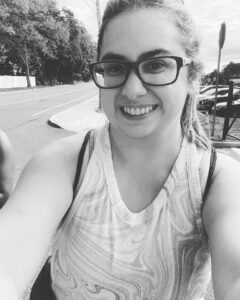Before you read on, make sure to check out Part 1 of Emily’s story. In Part 1, Emily discusses what Stickler syndrome is and her diagnostic journey. Today, we’ll discuss coming to terms with the diagnosis, managing her condition in college and beyond, and how Emily is doing today!
Understanding the Stickler Syndrome Diagnosis
Learning that she had Stickler syndrome was bittersweet. On one hand, Emily was finally able to put a name to her condition. At the same time, there are different subtypes of Stickler syndrome; while Emily’s doctor determined that she had this condition, her genetic test did not exclusively identify one subtype.
At the same time, her genetic test showed that she had a rare form of the disorder. She says:
“My mind went to the worst-case scenario and the ‘what if’ questions started. What if they couldn’t help me? Doctors had no information for me. Not only did I have a rare condition, but doctors mentioned that it was rare to have it match more than one subtype. Nobody could tell me what my future looked like. It felt like a death sentence to me.”
Emily did her best to stay positive. But one of the hardest parts of dealing with her diagnosis was the mental health struggles that came along for the ride. She explains:
“There were good, bad, and ugly days. I adapted a motto called ‘build a bridge and get over it.’ It helped me on the days when just existing was a struggle and I just wanted to hide and cry. People don’t realize that having a disability is not for the weak. You are a courageous, strong person if you have a disability. You learn things more quickly than most normal people. You see the world differently. Stickler syndrome took a toll on me when I was younger, but now I know why. To fight for others. To let people know that it’s okay to not be okay.”
She credits her family and her friends for being an amazing support system throughout this time. Her parents discovered a group called Stickler Involved People (SIP), a support group for those with Stickler syndrome. Her siblings went to doctors’ appointments and even conferences with Emily, doing everything they could to make her feel included. And her friends have been by her side for every bad day and every good day. Emily shares:
“Every single one of these people deserves an award, in my opinion. They tell me that I inspire them, but they inspire me to have hope and faith. They understand how hard this might be and they accept it. My parents fought for accommodation in school, fought for a diagnosis, and have always made sure that I had the same chances as everyone else. Without their support, I don’t think I would be here standing so strong.”
College and Beyond
During high school, Emily often turned to teachers who knew what she was going through and supported her. Other teachers didn’t seem to understand how hot classrooms could cause her pain to flare up or why she wasn’t more active. She only disclosed her condition to a handful of teachers and appreciates them for providing her with a safe space.
Emily later went to college with the goal of becoming a chef. She had a passion for food and loved combining different ingredients to develop something new and unique. However, her pain worsened, and she realized that the food industry just wasn’t for her.

At 21 years old, Emily learned that her parents had found a surgeon willing to operate on her hips. She was ecstatic at the chance to live pain-free (or at least have her pain significantly reduced). Emily explains:
“Before my hip replacement, I always had to put my disability front-and-center. I had to pick and choose what I could do and because of that, I missed out on life. I couldn’t do what my friends did because it would hurt so much after the fact. The heating pad was my best friend. After the hip replacement, I can say that I still have some limitations but I’m able to do more, from completing my first 2k to walking 11 miles in the city to waking up with zero pain.”
Prior to her hip replacement, Emily experienced some difficulty working in the office. She hid why she was often in pain (though she wonders if her coworkers bought it), because it was hard to explain her condition. Emily shares:
“I try not to tell non-doctor people about my Sticklers if I don’t need to. I don’t need the pity party. If I’m friendly with people, I may explain it simply and tell them that I have a rare condition affecting my joints, hearing, and sight. But I don’t want to be treated any differently and I feel like that happens sometimes when people learn about Stickler syndrome. At one job, a customer got upset that I was helping him because of my hearing loss. Other times, coworkers step in to help when I’m capable of doing things. I want people to know that Sticklers doesn’t define who I am or what I can do.”
Emily Today
Today, Emily works in book-keeping (which she absolutely loves). Emily still loves cooking. She enjoys traveling, especially to spots with warm climates. Sightseeing and just exploring an area excites her. Walking around without pain is amazing. She shares:
“I never take a single step for granted. I tend to live life to the fullest. I’m accomplishing a lot lately and doing things that I missed out on growing up. Every day is a surprise.”
Emily has also solidified her position as an advocate through the development of Next Generation Sticklers (“Nxtgensticklers”). The idea came to her during the COVID-19 pandemic, when she realized how many people missed interaction. The idea of Nxtgensticklers is to create a community for people with Stickler syndrome to share their stories. Each week, the community also offers a Zoom support group. After sharing her own story on the website, people began reaching out and telling her that because of her, they had found new hope. They no longer felt alone.

Emily’s goal, she says, is:
“To change the way the world sees those with disabilities. I want to show that we aren’t that different and bring more information to the table. I want to give everyone the same success that I had and see the ‘next generation’ taking these lessons and passing them along. I want to be the person I needed growing up. And I want people to know that they aren’t alone. For everyone living with a disability, your voice deserves to be heard.”






